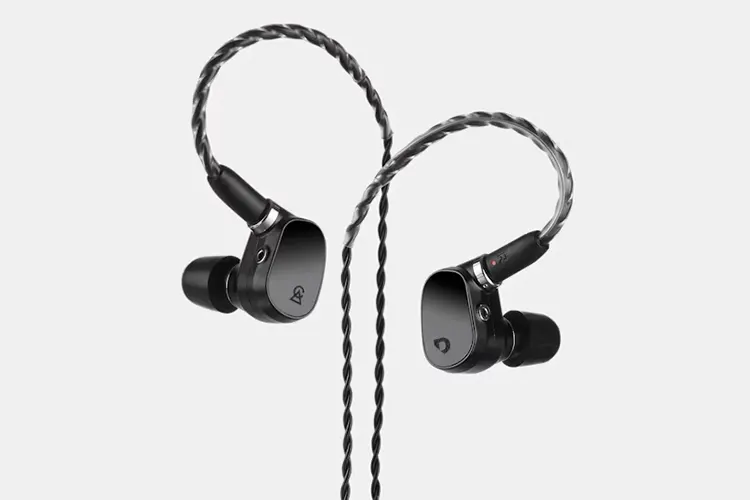Sound Impressions
The Dark Star was set to play continuously on the HiBy R4 for approximately 75 hours before critical assessment. Listening was done using the R4, Shanling M6 Pro, and the Astell&Kern AK120 Titan.
Comparisons are made to the Campfire Audio Solaris, Campfire Audio Supermoon, and the Spirit Torino Twin Pulse Beryllium IEM.
Summary
That density down low can either help or impede the overall signature. With the Dark Star, it helps hold down the signature, with a bleed that melds into the lower midrange of the Sonion BA, without impeding the structure of those mids.
The Knowles BAs up top provide a rich sparkle to the signature, that is not only additive to the overall sound but extends the reach without ‘tizziness’ or (too much) sibilance.
Balancing a fine line between the two treble notes, the Dark Star comes across as melodic and impactful.
Bass
There is no denying the Dark Star’s ever-present low end. But unlike the venerable Vega where that bass was an untamed beast (and appreciated for that), the Dark Star gives an excellent presentation to the lows.
When called upon, such as with an upright bass, that added grunt is appreciated for it lays the foundation to the song. When called upon in lesser amounts, the dynamic driver carries the low end with aplomb, giving support to the rest of the signature instead of a frontal attack.
Midbass tends to fall in line with the grunt of the low-end, which can bleed into the lower mids. There is sometimes an amount of bloom that pervades the senses, which can seem overwhelming when taken singularly.
However, when combined, understanding that the reality of what we hear is what is meant to be heard, the natural tendencies of the low-end come full circle promoting warmth and richness while leading into the midrange.
A slightly longer decay than attack (slowing the speed) helps to elongate those notes just enough allowing the signature to move into the mids without too much interference.

Mids
While the midrange sits slightly behind the rest, much like many CFA models, the quality cannot be denied. Vocal treatment is natural and organic with a personality of realism that transmits across both male and female vocals.
What you hear is what you should. The depth with which vocals play out is almost surreal in its holographic nature.
Easily heard are the full width and breadth of each track that promotes vocals honestly and with a vibrant character working in concert with that organic sensation.
The depth of what comes across helps the midrange not get lost, even if it sits slightly back. There is some sibilance, but only what you would hear from the respective track, which adds to that naturalness in sound quality and clarity-driven detail retrieval.
The coherent nature of the midrange plays a huge part in tying the ends together while providing the bridged girth that you hear on most tracks. But with that said, on some complicated tracks, there can be a bit of a fluster as the Dark Star tries to keep all coherent.
Much of this can be put down to the recording levels of the tracks, but instead of covering this complicatedness, the Dark Star provides a reality check to the midrange, which is quite refreshing.
Treble
The reach of the two Knowles’s balanced armatures makes themselves known. The extension stretches the top but does so without thinning the notes. That extension does carry forward the sibilance buried into tracks but does so with the right amount of sparkle.
Where the low-end delivers that rumble letting you know what is going on, the sparkle up top does the same, while the coherence of the midrange ties it together, without taking credit.
There is a piezo-like effect, much like the Astrolith portrays, which seems counter to a balanced armature. However, this is done with great effectiveness and presents transient responses with a crispness that carries excellent clarity.
Electric guitar work, which highlights the lower treble region comes across with just the right amount of attack and decay, making for a speedy presentation, but with excellent note weight.
A sparkle-laden treble is not my favorite treatment, but with the Dark Star, CFA has hit it quite well, giving me enjoyment without stressing my hindrance of a top-end approach.
That speed and sparkle (and brilliance) combine to make for a vibrant top-end, which has a fun factor to it, that will appeal across many genres.

Staging & Dynamics
Starting with the familial resemblance to the wonderful soundstage in the Solaris (and the shape), the Dark Star comes across as expansive in breadth, depth, and height. It does so without becoming thin of note quality, either.
There is a large openness to the soundstage, which allows everything to spread out giving an almost holographic effect to it all. The 3D feeling carries across the stage no matter the song or genre.
Vocals sound semi-dominant in the center, even if moved a bit towards the back on some tracks. Holding down the center allows the rest to fill in surrounding it, giving instruments the room to breathe. This in turn allows for that 3D character.
One might think with that allowance of spreading out, that the rest (depth and height) might suffer.
Instead, the Dark Star is not only one of the most cubic of late but also expansive in all directions. There is no intimacy here, only a large-venue-like response, but without losing any detail or crispness to the whole.
This too allows for excellent response almost to the edges, with only a slight loss in detail at the edge of the width. Depth is harder for me to judge out that far, but height makes up for it, with excellent detail retrieval to the top and bottom. This may account for the holography going on.
Dynamically speaking, the Dark Star is very good, with a quick response to changes, but without being thin in quality. The quick shifts also proceed to represent very good imaging, as the left/right interactions move with vigor and coherence.
Synergy
Efficiency
The Dark Star requires 7.74 mVrms at 1kHz to attain an SPL of 94 dB with an impedance of 9.212Ω, making it easy to drive no matter the source.
Where some CFA models seemingly take on the qualities of the source, the Dark Star not only does that, less than others, but couples it within the signature.
While the HiBy R4 is not nearly as rich and warm sounding as the Shanling M6 Pro, the Dark Star never became too rich in sound or too warm when paired with the warmer signature Shanling.
With a neutral source such as the (ancient) A&K Titan, the pairing allowed the best of each to come forth.
The Dark Star worked well across many sources, lending its signature, but never overwhelming the source. It played nicely across all sources used as a result.
Pairings
Even though the Dark Star proved to be source-insensitive, there were some differences, which allowed for good comparisons. And I cannot, in good faith, determine which might be better or not, only differences.
The HiBy R4 saw a major part of the listening time and carried itself well. Not the most detailed DAP around, but with a good musical nature to it, the Dark Star came across with deep lows and vibrant, sparkly treble notes, and the aforementioned midrange, which sang so nicely.
The A&K AK120 Titan is an older (ancient) DAP, which came my way when I picked up a couple of headphones as well. Known as one of the (many) first touchscreen DAPs, the sound represented its upscale price. The pairing is superb, with excellent detail retrieval, and spatial characteristics.
Bass, while not as thunderous as the R4, comes across as succinct and tight, while the neutral characteristics carry across the signature. With enough power to boot, the Titan can play music from the Dark Star at levels that are quite high.
The Shanling M6 Pro may be long in the tooth as well, but it remains a favorite of mine. With the warmest signature of the sources here, this did not dissuade from detail quality.
Richness indeed did pervade the signature, but with excellent rumble down low and an extension, which came across as the preferred treatment of the sources used.
Bubbly and vibrant, but with richness and warmth to even the signature out, the rumble down low paired with the holographic nature of the signature very well.







